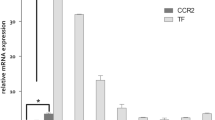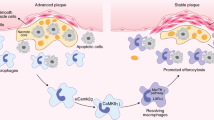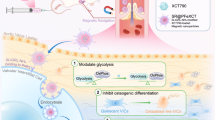Abstract
Gene therapy is expected to open a new strategy for the treatment of refractory vascular diseases, so the development of appropriate gene vectors for vascular lesions is needed. To realize this requirement with a non-viral approach, cyclo(RGDfK) peptide (cRGD) was introduced to block copolymer, poly(ethylene glycol)-block-polycation carrying ethylenediamine units (PEG-PAsp(DET)). cRGD recognizes αvβ3 and αvβ5 integrins, which are abundantly expressed in vascular lesions. cRGD-conjugated PEG-PAsp(DET) (cRGD-PEG-PAsp(DET)) formed polyplex micelles through complexation with plasmid DNA (pDNA) and the cRGD-PEG-PAsp(DET) micelles achieved significantly more efficient gene expression and cellular uptake as compared with PEG-PAsp(DET) micelles in endothelial cells and vascular smooth muscle cells. Intracellular tracking of pDNA showed that cRGD-PEG-PAsp(DET) micelles were internalized via caveolae-mediated endocytosis, which is associated with a pathway avoiding lysosomal degradation and that, PEG-PAsp(DET) micelles were transported to acidic endosomes and lysosomes via clathrin-mediated endocytosis. Further, in vivo evaluation in rat carotid artery with a neointimal lesion revealed that cRGD-PEG-PAsp(DET) micelles realized sustained gene expression, whereas PEG-PAsp(DET) micelles facilitated rapid, but transient gene expression. These findings suggest that introduction of cRGD to polyplex micelles might create novel and useful functions for gene transfer and contribute to the establishment of efficient gene therapy for vascular diseases.
This is a preview of subscription content, access via your institution
Access options
Subscribe to this journal
Receive 12 print issues and online access
$259.00 per year
only $21.58 per issue
Buy this article
- Purchase on Springer Link
- Instant access to full article PDF
Prices may be subject to local taxes which are calculated during checkout







Similar content being viewed by others
References
Taniyama Y, Tachibana K, Hiraoka K, Namba T, Yamasaki K, Hashiya N et al. Local delivery of plasmid DNA into rat carotid artery using ultrasound. Circulation 2002; 105: 1233–1239.
Nishikage S, Koyama H, Miyata T, Ishii S, Hamada H, Shigematsu H . In vitro electroporation enhances plasmid-based gene transfer of basic fibroblast growth factor for the treatment of ischemic limb. J Surg Res 2004; 120: 37–46.
Tomanin R, Scarpa M . Why do we need new gene therapy viral vectors? Characteristics, limitations and future perspectives of viral vector transduction. Curr Gene Ther 2004; 4: 357–372.
Edelstein ML, Abedi MR, Wixon J . Gene therapy clinical trials worldwide to 2007—an update. J Gene Med 2007; 10: 833–842.
Pack DW, Hoffman AS, Pun S, Stayton PS . Design and development of polymers for gene delivery. Nat Rev Drug Discovery 2005; 4: 581–593.
Mastrobattista E, van der Aa MA, Hennink WE, Crommelin DJA . Artificial viruses: a nanotechnological approach to gene delivery. Nat Rev Drug Discovery 2006; 5: 115–121.
Wagner E, Ogris M, Zauner W . Polysine-based transfection systems utilizing receptor-mediated delivery. Adv Drug Deliv Rev 1998; 30: 97–113.
Oupicky D, Konak C, Ulbrich K, Wolfert MA, Seymour LW . DNA delivery systems based on complexes of DNA with synthetic polycations and their copolymers. J Control Release 2000; 65: 149–171.
Pedroso de Lima MC, Simoes S, Pires P, Faneca H, Duzgunes N . Cationic lipid-DNA complexes in gene delivery: from biophysics to biological applications. Adv Drug Delivery Rev 2001; 47: 277–294.
Merdan T, Kopecek J, Kissel T . Prospects for cationic polymers in gene and oligonucleotide therapy against cancer. Adv Drug Delivery Rev 2002; 54: 715–758.
Ogris M, Brunner S, Schuller S, Kircheis R, Wagner E . PEGylated DNA/transfection-PEI complexes: reduced interaction with blood components, extended circulation in blood and potential for systemic gene delivery. Gene Therapy 1999; 6: 595–605.
Oupicky D, Konak D, Dash PR, Seymour LW, Ulbrich K . Effect of albumin and polyanion on the structure of DNA complexes with polycation containing hydrophilic nonionic block. Bioconjug Chem 1999; 10: 764–772.
Kakizawa Y, Kataoka K . Block copolymer micelles for delivery of gene and related compounds. Adv Drug Delivery Rev 2002; 54: 203–222.
Katayose S, Kartaoka K . Water-solubule polyion complex association of DNA and poly (ethylene glycol)-poly(L-lysine) block copolymer. Bioconjug Chem 1997; 8: 702–707.
Osada K, Kataoka K . Drug and gene delivery based on supramolecular assembly of PEG-polypeptide hybrid block copolymers. Adv Polym Sci 2006; 202: 113–153.
Itaka K, Harada A, Nakamura K, Kawaguchi H, Kataoka K . Evaluation by fluorescence resonance energy transfer of the stability of nonviral gene delivery vectors under physiological conditions. Biomacromolecules 2002; 3: 841–845.
Harada-Shiba M, Yamauchi K, Harada A, Takamizawa I, Shimokado K, Kataoka K . Polyion complex micelles as vectors in gene therapy-pharmakokinetics and in vivo gene transfer. Gene Therapy 2002; 9: 407–414.
Itaka K, Yamanouchi K, Harada A, Nakamura K, Kawaguchi H, Kataoka K . Polyion complex micelles from plasmid DNA and poly(ethylene glycol)-poly(L-lysine) block copolymer as serum-tolerable polyplex system: physicochemical properties of micelles relevant to gene transfection efficiency. Biomaterials 2003; 24: 4495–4506.
Han M, Bae Y, Nishiyama N, Miyata K, Oba M, Kataoka K . Transfection study using multicellular tumor spheroids for screening non-viral polymeric gene vectors with low cytotoxicity and high transfection efficiencies. J Control Release 2007; 121: 38–48.
Akagi D, Oba M, koyama H, Nishiyama N, Fukushima S, Miyata T et al. Biocompatible micellar nanovectors achieve efficient gene transfer to vascular lesions without cytotoxicity and thrombus formation. Gene Therapy 2007; 14: 1029–1038.
Kanayama N, Fukushima S, Nishiyama N, Itaka K, Jang W-D, Miyata K et al. A PEG-based biocompatible block catiomer with high buffering capacity for the construction of polyplex micelles showing efficient gene transfer toward primary cells. Chem Med Chem 2006; 1: 439–444.
Itaka K, Ishii T, Hasegawa Y, Kataoka K . Biodegradable polyamino acid-based polycations as safe and effective gene carrier minimizing cumulative toxicity. Biomaterials 2010; 31: 3707–3714.
Miyata K, Oba M, Nakanishi M, Fukushima S, Yamasaki Y, Koyama H et al. Polyplexes from poly(aspartamide) bearing 1,2-diaminoethane side chains induce pH-selective, endosomal membrane destabilization with amplified transfection and negligible cytotoxicity. J Am Chem Soc 2008; 130: 16287–16294.
Wakebayashi D, Nishiyama N, Yamasaki Y, Itaka K, Kanayama N, Harada A et al. Lactose-conjugated polyion complex micelles incorporating plasmid DNA as a targetable gene vector system: their preparation and gene transfecting efficiency against cultured HepG2 cells. J Control Release 2004; 95: 653–664.
Suh W, Han SO, Yu L, Kim SW . An angiogenic endothelial-cell-targeted polymeric gene carrier. Mol Ther 2002; 6: 664–672.
Ogris M, Walker G, Blessing T, Kircheis R, Wolschek M, Wagner E . Tumor-targeted gene therapy: strategies for the preparation of ligand-polyethylene glycol-polyethylenimine/DNA complexes. J Control Release 2003; 91: 173–181.
Haubner R, Gratias R, Diefenbach B, Goodman SL, Jonczyk A, Kessler H . Structural and functional aspects of RGD-containing cyclic pentapeptides as highly potent and selective integrin αvβ3 antagonist. J Am Chem Soc 1996; 118: 7461–7472.
Brooks PC, Clark RAF, Cheresh DA . Requirement of vascular integrin αvβ3 for angiogenesis. Science 1994; 264: 569–571.
Kim WJ, Yockman JW, Lee M, Jeong JH, Kim YH, Kim SW . Soluble Flt-1 gene delivery using PEI-g-PEG-RGD conjugate for anti-angiogenesis. J Control Release 2005; 106: 224–234.
Kim WJ, Yockman JW, Jeong JH, Christensen LV, Lee M, Kim YH et al. Anti-angiogenic inhibition of tumor growth by systemic delivery of PEI-g-PEG-RGD/pCMV-sFlt-1 complexes in tumor-bearing mice. J Control Release 2006; 114: 381–388.
Choi ET, Engel L, Callow AD, Sun S, Trachtenberg J, Santoro S et al. Inhibition of neointimal hyperplasia by blocking alpha V beta 3 integrin with a small peptide antagonist GpenGRGDSPCA. J Vasc Surg 1994; 19: 125–134.
Hoshiga M, Alpers CE, Smith LL, Giachelli CM, Schwartz SM . Alpha-v beta-3 integrin expression in normal and atherosclerotic artery. Circ Res 1995; 77: 1129–1135.
van der Zee R, Murohara T, Passeri J, Kearney M, Cheresh DA, Isner JM . Reduced intimal thickening following alpha(v)beta3 blockade is associated with smooth muscle cell apoptosis. Cell Adhes Common 1998; 6: 371–379.
Srivatsa SS, Fitzpatrick LA, Tsao PW, Reilly TM, Holmes Jr DR, Schwartz RS et al. Selective alpha v beta 3 integrin blockade potently limits neointimal hyperplasia and lumen stenosis following deep coronary arterial stent injury: evidence for the functional importance of integrin alpha v beta 3 and osteopontin expression during neointima formation. Cardiovasc Res 1997; 36: 408–428.
Kokudo T, Uchida H, Choi ET . Integrin αvβ3 as a target in the prevention of neointimal hyperplasia. J Vasc Surg 2007; 45: 33–38.
Oba M, Fukushima S, Kanayama N, Aoyagi K, Nishiyama N, Koyama H et al. Cyclic RGD peptide-conjugated polyplex micelles as a targetable gene delivery system directed to cells possessing αvβ3 and αvβ5 integrins. Bioconjugate Chem 2007; 18: 1415–1423.
Oba M, Aoyagi K, Miyata K, Matsumoto Y, Itaka K, Nishiyama N et al. Polyplex micelles with cyclic RGD peptide ligands and disulfide cross-links directing to the enhanced transfection via controlled intracellular trafficking. Mol Pharm 2008; 5: 1080–1092.
Grosse S, Aron Y, Thevenot G, Francosis D, Monsigny M, Fajac I . Potocytosis and cellular exit of complexes as cellular pathway for gene delivery by polycations. J Gene Med 2005; 7: 1275–1286.
Wickman TJ, Filardo EJ, Cheresh DA, Nemerow GR . Integrin αvβ5 selectively promotes adenovirus mediated cell membrane permeabilization. J Cell Biol 1994; 127: 257–264.
Wary KK, Mainiero F, Isakoff SJ, Marcantonio EE, Giancotti FG . The adaptor protein Shc couples a class of integrin to the control of cell cycle progression. Cell 1996; 87: 733–743.
Wary KK, Mariotti A, Zurzolo C, Giancotti FG . A requirement for caveolin-1 and associated kinase Fyn in integrin signaling and anchorage-dependent cell growth. Cell 1998; 94: 625–634.
Marinelli L, Gottschalk KE, Meyer A, Novellino E, Kessler H . Human integrin αvβ5: homology modeling and ligand binding. J Med Chem 2004; 47: 4166–4177.
Oba M, Miyata K, Osada K, Christie RJ, Sanjoh M, Li W et al. Polyplex micelles prepared from ω-cholesteryl PEG-polycation block copolymers for systemic gene delivery. Biomaterials 2011; 32: 652–663.
Stary HC, Blankenhorn DH, Chandler AB, Glagov S, Insull Jr W, Richardson M et al. A definition of the intima of human arteries and of its atherosclerosis-prone regions. A report from the Committee on Vascular Lesions of the Council on Arteriosclerosis, American Heart Association. Circulation 1992; 85: 391–405.
Guzman RJ, Lemarchand P, Crystal RG, Epstein SE, Finkel T . Efficient and selective adenovirus-mediated gene transfer into vascular neointima. Circulation 1993; 88: 2838–2848.
Pelkmans L, Kartenbeck J, Helenius A . Caveolar endocytosis of simian virus 40 reveals a new two-step vesicular transport pathway to the ER. Nat Cell Biol 2001; 3: 473–483.
Acknowledgements
This work was supported by Special Coordination Funds for Promoting Science and Technology from the Ministry of Education, Culture, Sports, Science and Technology (MEXT), and the Core Research Program for Educational Science and Technology (CREST) from the Japan Science and Technology Corporation (JST).
Author information
Authors and Affiliations
Corresponding author
Ethics declarations
Competing interests
The authors declare no conflict of interest.
Rights and permissions
About this article
Cite this article
Kagaya, H., Oba, M., Miura, Y. et al. Impact of polyplex micelles installed with cyclic RGD peptide as ligand on gene delivery to vascular lesions. Gene Ther 19, 61–69 (2012). https://doi.org/10.1038/gt.2011.74
Received:
Revised:
Accepted:
Published:
Issue Date:
DOI: https://doi.org/10.1038/gt.2011.74
Keywords
This article is cited by
-
Polymeric micelles and cancer therapy: an ingenious multimodal tumor-targeted drug delivery system
Drug Delivery and Translational Research (2023)
-
The use of nanotechnology in cardiovascular disease
Applied Nanoscience (2018)
-
A review of RGD-functionalized nonviral gene delivery vectors for cancer therapy
Cancer Gene Therapy (2012)



